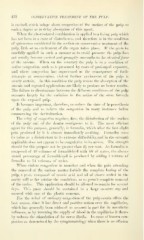Page 424 - My FlipBook
P. 424
422 CONSERVATIVE TREATMENT OF THE PULP.
is excited, which brings about congestion of tlie surface of tlie pulp to
such a degree as to delay absor})tion of this agent.
When the above-stated combination is applied to a living pulp which
has not been in a state of disturban(;e, and therefore is in the condition
of quiescence considered in the section on conservative treatment of the
pulp, little or no excitement of the organ takes place. If the paste be
carefully a})j)licd in such a manner as to avoid pressure the pulp does
not usually become excited and promptly succumbs to the chemical force
of the arsenic. When on the contrary the pulp is in a condition of
active congestion, such as is presented by cases of prolonged exposure,
and where congestion has supervened as the consequence of futile
attempts at conservation, violent further excitement of the pulp is
nearly certain. In this condition the pulp resists the absorption of the
arsenic and repeated applications are likely to produce no better results.
The failure to discriminate between the different conditions of the pulp
accounts largely for the variation in the action of the same formula
upon the exposed pulp.
It becomes important, therefore, to reduce the state of hyperesthesia
of the pulp and to relieve the congestion in many instances before
commencing the devitalization.
The 7'clief of conf/e.stion requires, first, the disinfection of the surface
of the pulp' and of the dentin contiguous to it. The most efficient
agent for this purpose, generally, is formalin, which after the first slight
pain produced by it is almost immediately soothing. Formalin owes
its value as a disinfectant to its extreme diffusibilityand in the strength
applicable does not appear to be coagulative in its action. The strength
should for this purpose not be greater than 2^- per cent. As formalin is
composed of 40 volumes of formaldehycl with 60 of water, the above-
stated percentage of formaldehyd is produced by adding 1 volume of
formalin to 14 volumes of water.
When violent congestion is manifest and when the pain attending
the removal of the carious matter forbids the complete baring of the
pulp, a paste composed of tannic acid and oil of cloves sealed in the
cavity will so far subdue the conditions as to permit complete removal
of the caries. This application should be allowed to remain for several
days. This ])aste should be contained in a large concave cap and
secured with one of the plastic cements.
For the relief of ordinary congestion of the pulp cocain offers the
best means, since it has direct and positive action over the capillaries,
which has generally been adduced to account in part for its anesthetic
influence, as by lessening the supply of blood in the capillaries it there-
by reduces the stimulation of the nerve fibrils. In cases of known con-
gestion as determined by the symptomatology when there is no effusion


